Working from home is a good balance between work and private life
Working from home provides a large degree of freedom and room for achieving a good balance between work and private life. On the other hand, it places much greater demands on us regarding personal responsibility and time management.
Home study
Working from home is a new reality. Finding the right place in your home is a problem sometimes, particularly where space is at a premium. Where it is not possible to dedicate a room, it is necessary to create a work corner where you can concentrate on work without being disturbed. The best space in this case is the living room. You should not work in the room in which you rest – the bedroom.
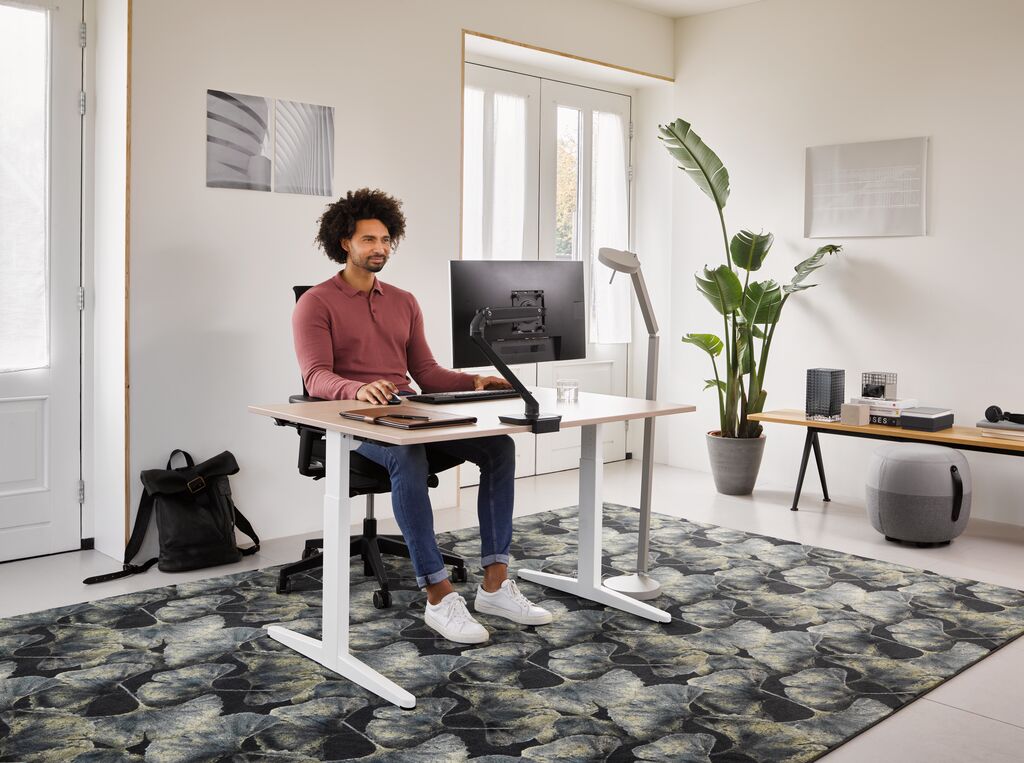
Difficulties of working from home
We spend too much time sitting and don’t exercise enough. We make use of the existing household furnishings, which are not intended for such a task and subject our bodies to stress and health problems.
How to healthily work from home and what to pay attention to?
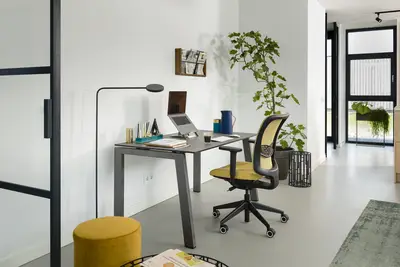
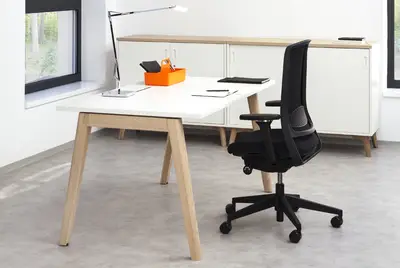
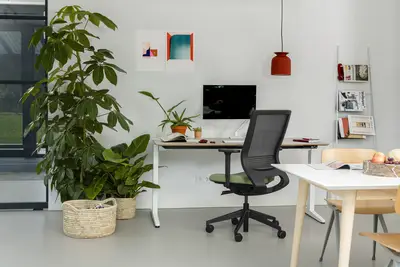
An ergonomic chair, a height-adjustable desk and external monitor. These are the basic ingredients that help transform a guest room or other living space into an ideal work environment.
Desk
We can create a comfortable and functional office in a domestic environment regardless of the size of the space. We can choose the desk that suits us best and fits best into our interior.
Alfa 200 - Classic style
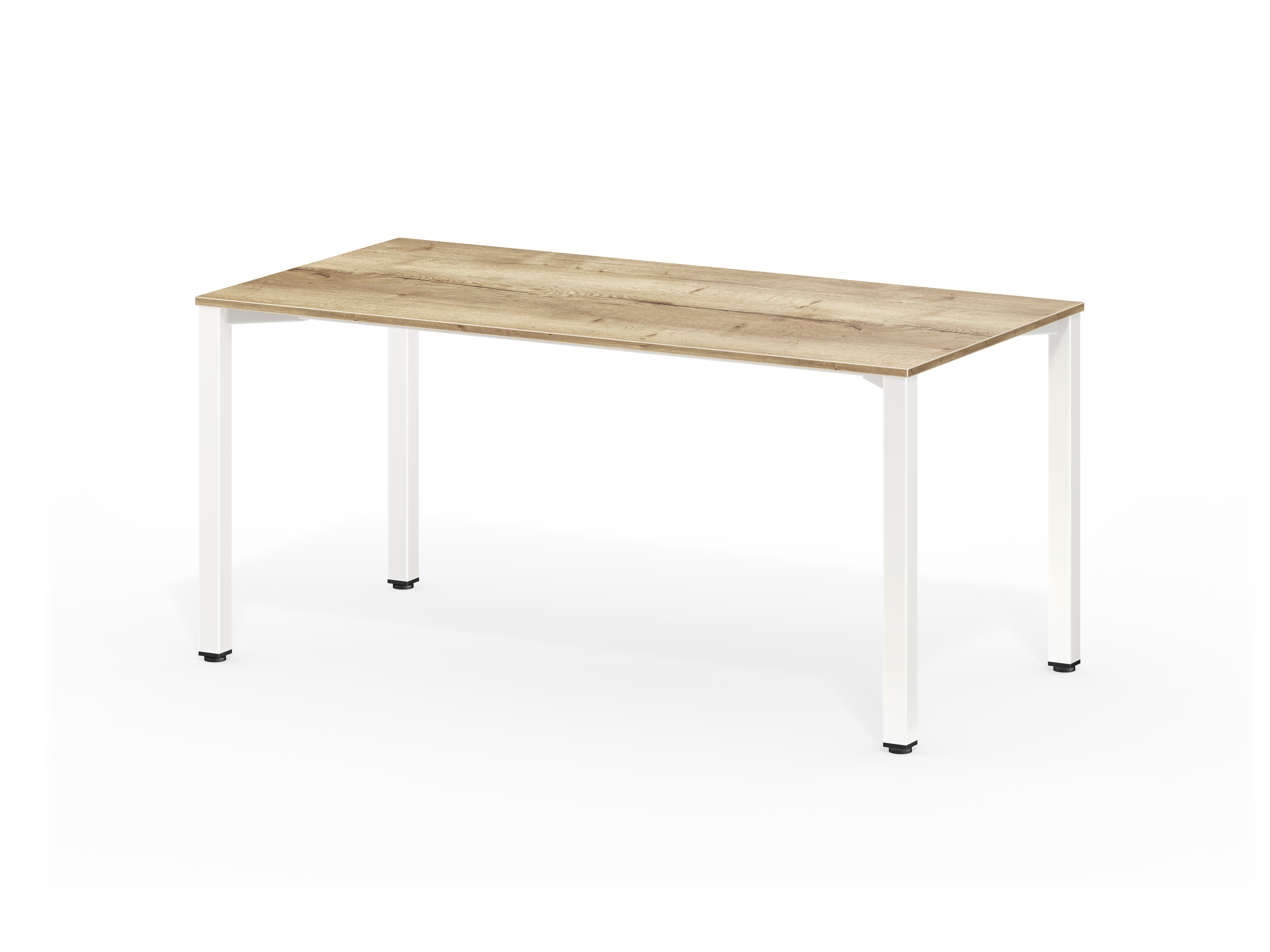
Classic four-leg desk with a steel frame.
- Legs 50 x 50 mm cross section
- Desktops MFC white, oak 18 mm, ABS edge
- Desktop dimensions 1200, 1400, 1600 x 800 mm
- Desk height 735 mm
- On request it is possible to supply a height-adjustable option in the range 740 - 880 mm and leg cover
Get inspired:
Root - Natural wood
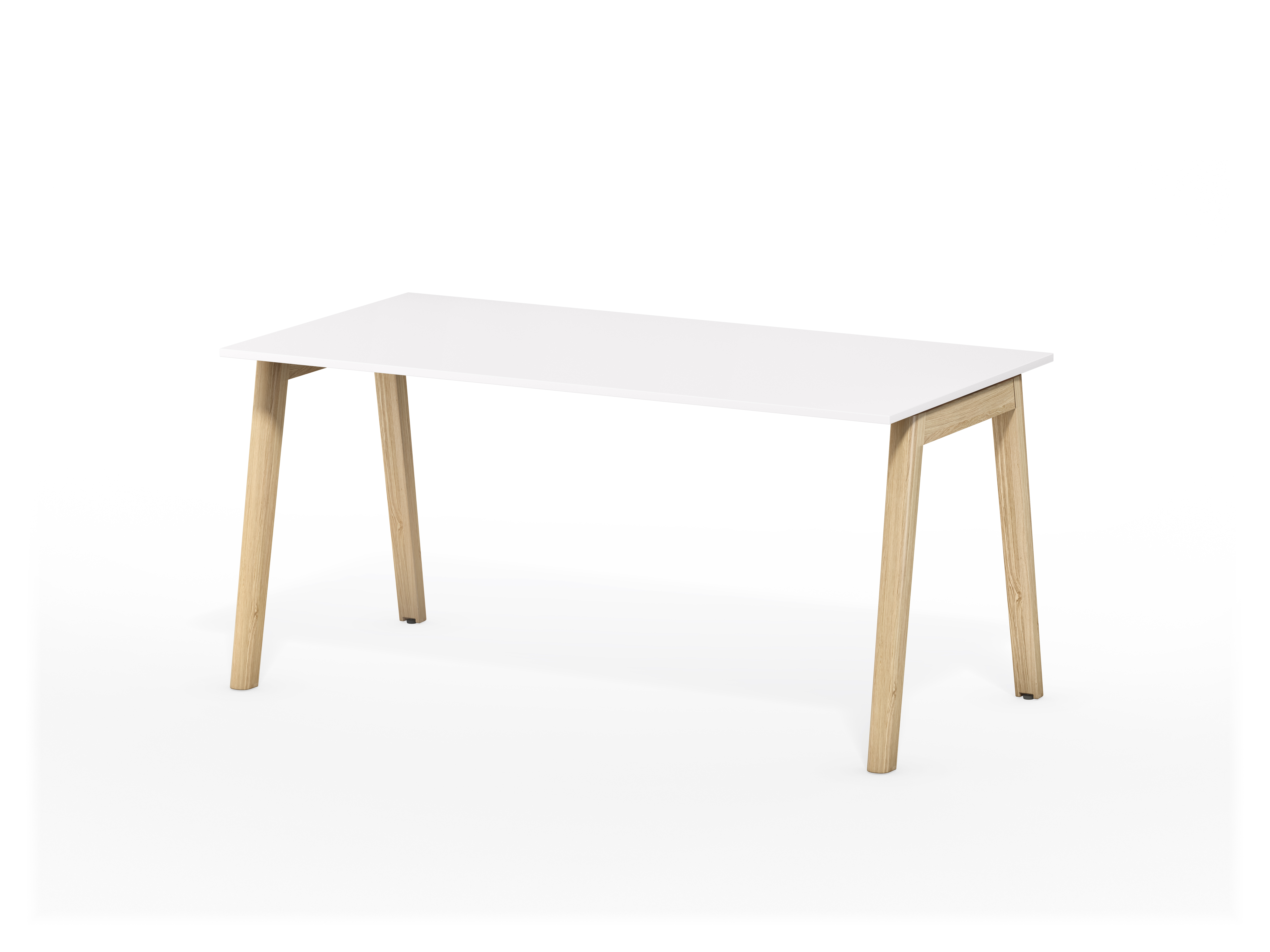
Four-leg desk made from solid ash wood, which adds a touch of luxury to the interior.
- The leg sections are made from solid wood – ash
- Desktop MFC white, oak 18 mm, ABS edge
- Desktop dimensions 1200, 1400, 1600 x 800 mm
- Desk height 735 mm
Get inspired:
Alfa Up - Height adjustable
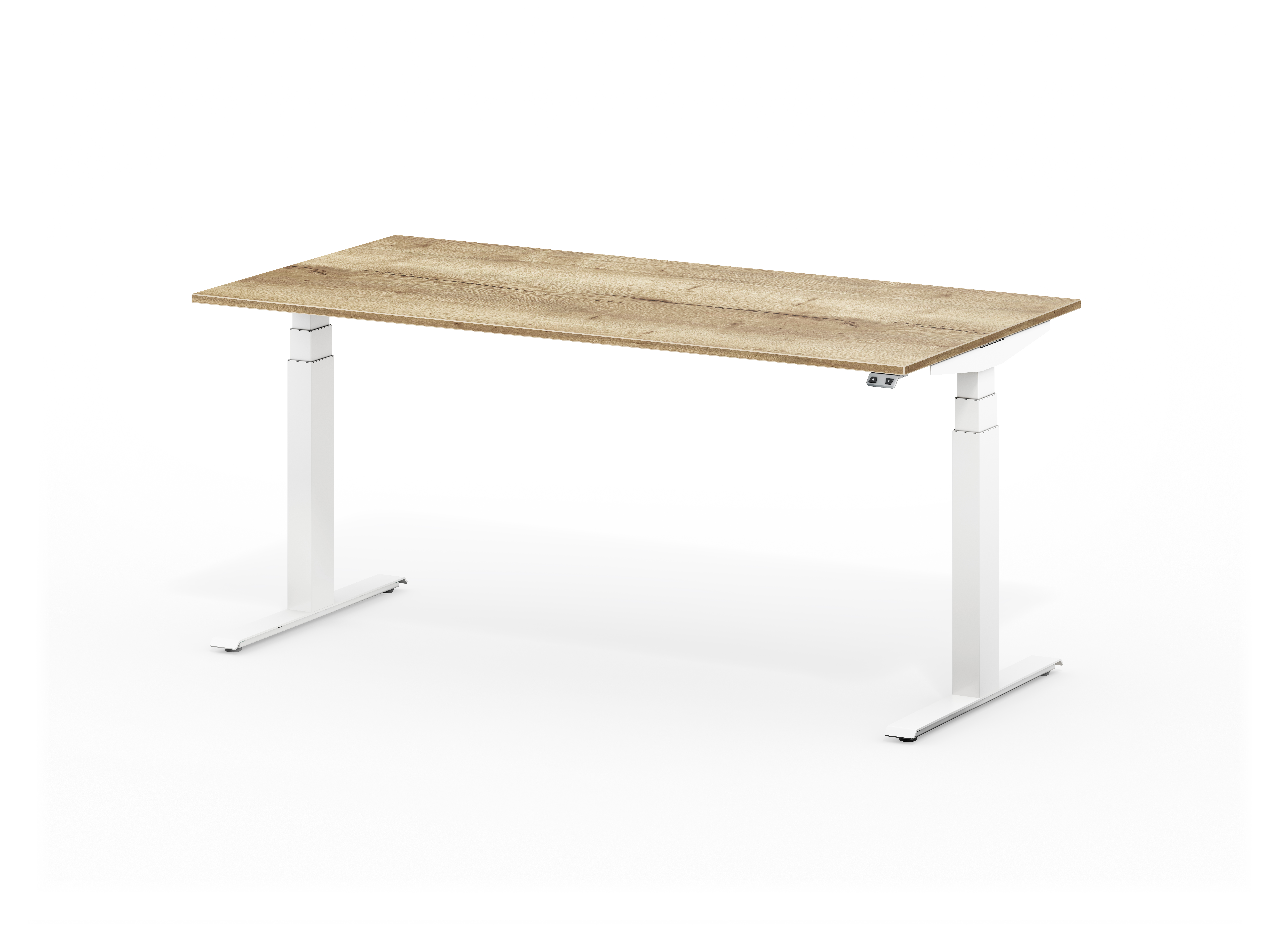
Height-adjustable desk with a synchronous lifting mechanism that enables work either seated or standing.
• Electrically operated height-adjustable desk
• Steel construction
• Desktop MFC white, oak 18 mm, ABS edge
• Desktop dimensions 1200, 1400, 1600 x 800 mm
• Height: 615 - 1275 mm
Get inspired:
Ergonomic chair
A good chair supports your back and arms whilst also giving the body the freedom to move. Chairs play the most important role in creating a healthy work environment. If we sit for long hours on an uncomfortable chair, the body tries to adjust to this discomfort by tightening various muscles in an effort to find a more comfortable position. This can lead to incorrect posture and muscles can ache, and repetitive strain injury can also occur. If we sit correctly the body is supported by the chair and the muscles are able to relax.
I AM
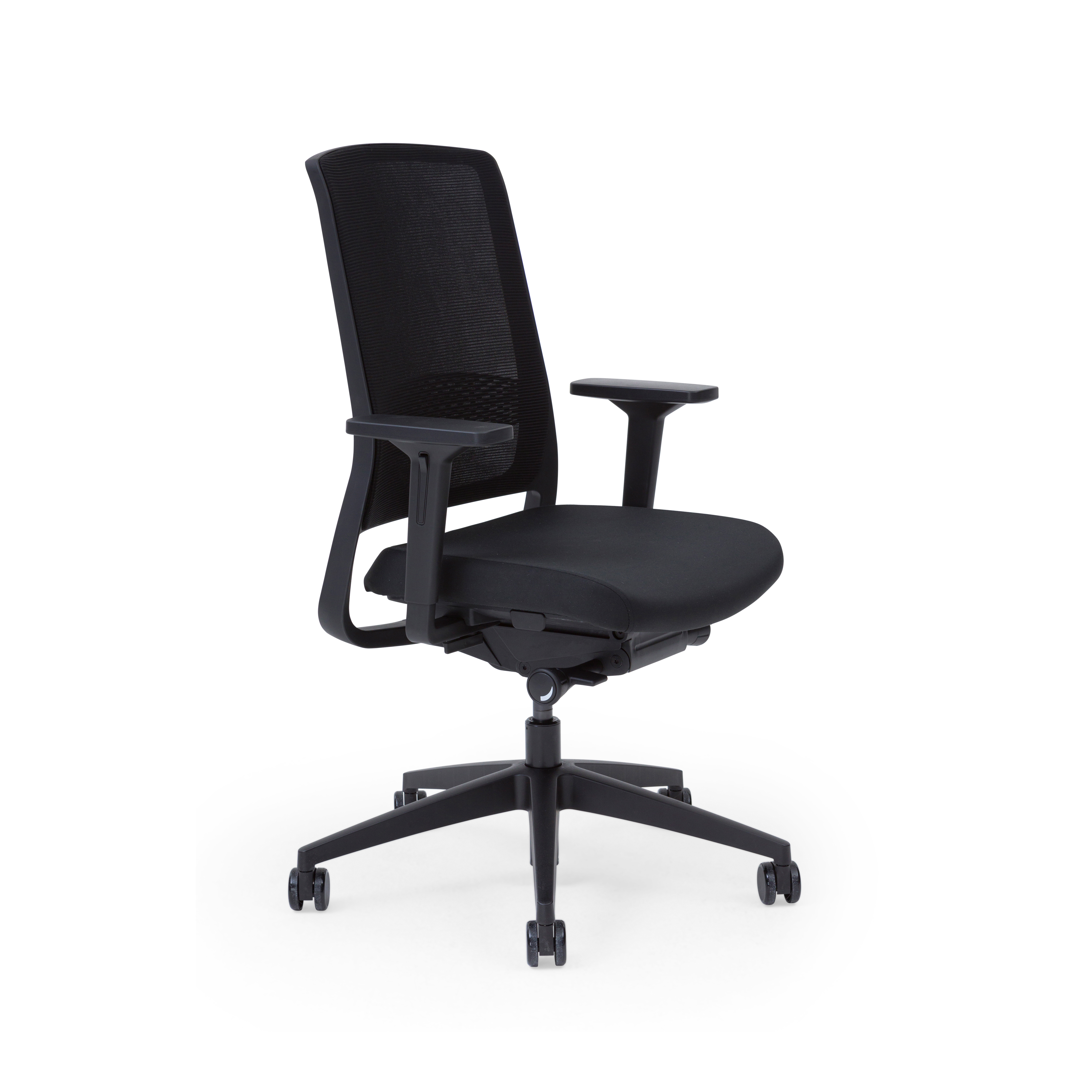
You will feel comfortable right away thanks to the well-matched proportions of the seat and back, as well as the properties of the flexible backrest. You can adjust the I AM office chair to your preferred setting via the synchronous mechanism.
Get inspired:
Sidiz
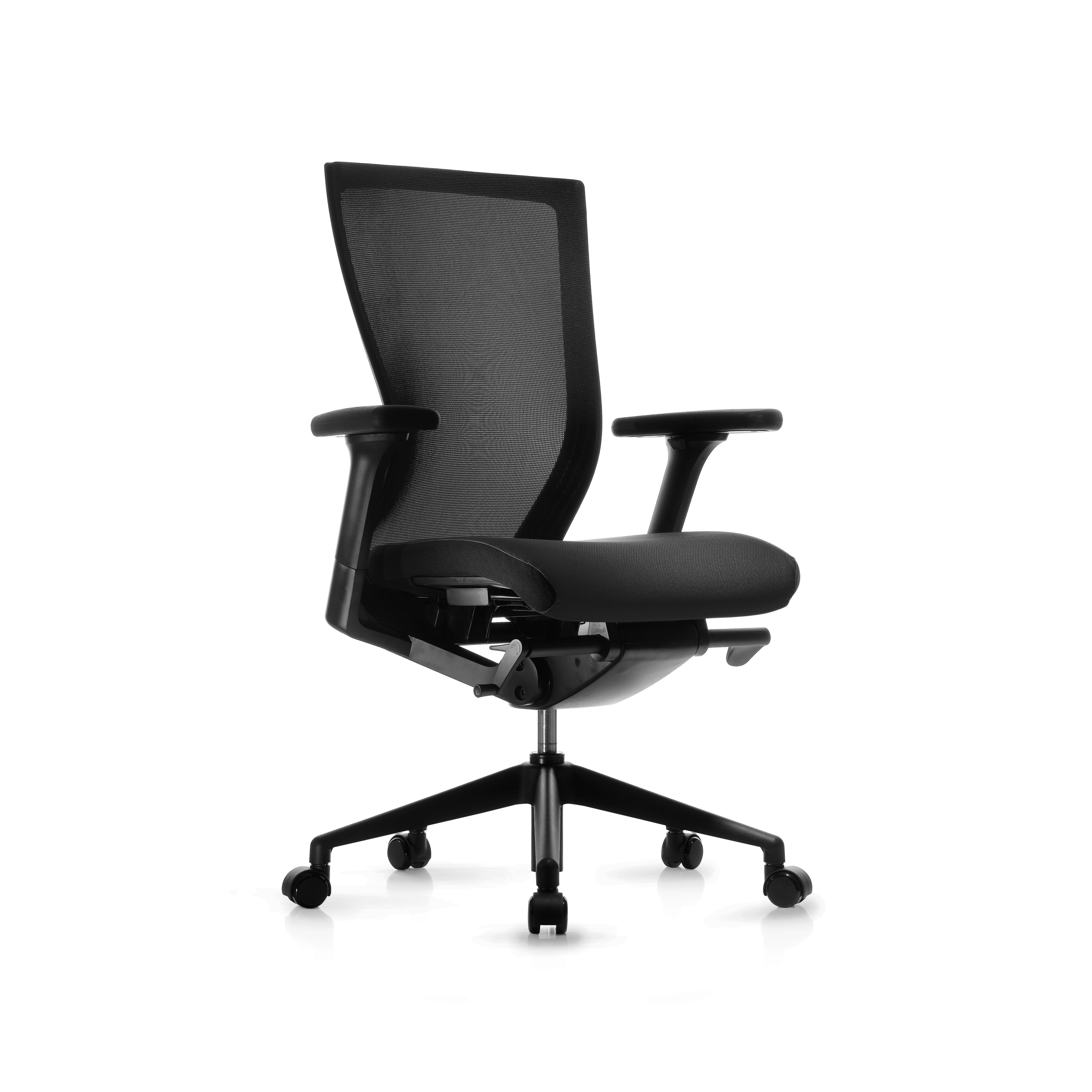
The elegant Sidiz task chair will be your best friend. It provides you with such a degree of comfort that you forget about the world around you, which helps you achieve great results.
Get inspired:
Seat height
Seat height should be set so that your feet are flat on the floor and your legs have an angle of 90 - 120° at the knee.
Armrest adjustment
The armrests should be set so an elbow angle of 90 - 120° is achieved. The armrest can be moved backwards and forwards as required.
Synchronous mechanism
The seat and backrest respond independently to the movements and shifting weight of the user.
Seat depth
The seat can be moved backwards or forwards so that your back rests against the backrest and the seat does not cause pressure under the knees.
Setting the backrest tension
The backrest tension can be adjusted to suit our bodyweight. For correct posture, move the lumbar support up or down as needed.
Change
Every now and then we should stand and stretch – maybe for 1 to 2 minutes every hour.
Alternate between sitting and standing when working
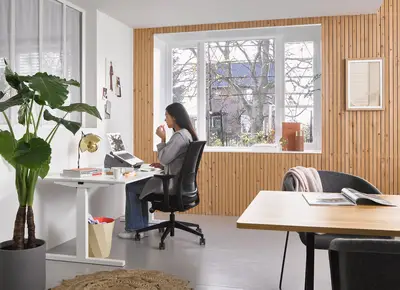
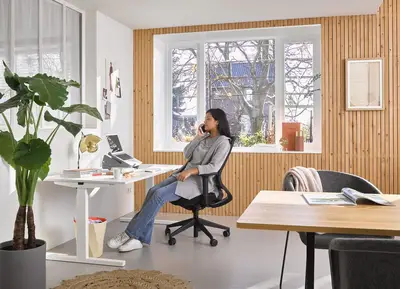
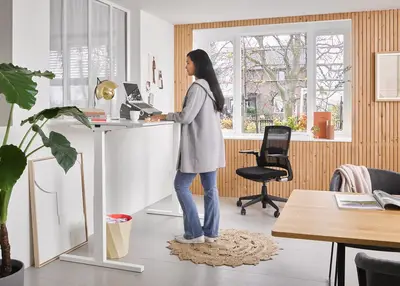
We often forget to take sufficient exercise. This damages our health. When we change working positions, we improve our circulation, which refreshes our energy levels. Alternating between sitting and standing at work promotes good health and improves the creativity and productivity of work. A study showed that 71% of employees felt healthier and 46% were more productive.
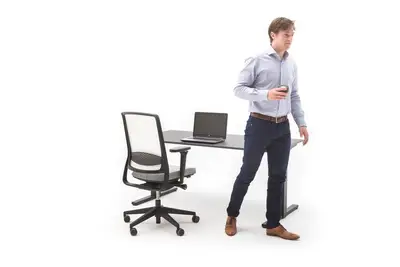
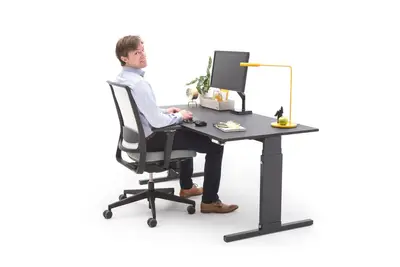
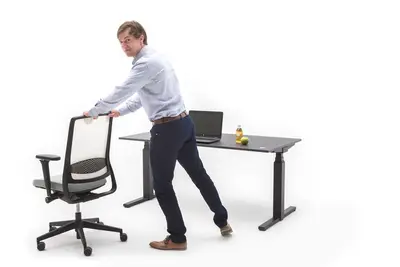
Healthy seating
Head
Sit with your head centred over your shoulders. If you find that you sit hunched over, gently pull your shoulders backward and tuck in your chin
Shoulders
Relax your shoulders so your arms dangle comfortably at your sides. Keep your shoulders relaxed while typing at the keyboard.
Elbow
Bend your elbow at a comfortable angle between 90—120 degrees.
Wrists & Hands
While working on a computer, keep your wrists in a straight line with your arms. Avoid bending your wrists too far to the right or left and too far back. A wrist rest may help act as a guide to keep your wrists straight.
Lower Back
The chair back should support your lower back. If it does not, place a small pillow between your back and the chair.
Knees
While seated, bend your knees at a comfortable angle between 90—120 degrees. The edge of the chair should not dig into the back of your knees.
Ankles and Feet
Your feet should rest flat on the floor when seated. If your feet do not reach the floor, use a foot rest. Keep enough room around your feet so they can move back and forth.
Keyboard
Keep your wrists straight when typing. Use a light touch on the keys, and avoid resting on your wrists.
Mouse
Place your mouse at the same level as your keyboard and keep it in easy reach. Use arm movements not wrist movements to move the mouse.
Monitor
Place the computer monitor directly in front of you to avoid twisting to view it. The monitor should be about an arm's length away and the top just below eye level. Tilt and swivel the monitor slightly to remove glare from other light sources.
Chair Adjustments
Your chair should comfortably support your lower back without brushing against your inner calf. It should also let your feet rest flat on the floor. If your chair is not adjustable, a pillow behind your back and a phone book or binder under your feet can help provide needed support.
Accessories
Accessories can be used to help create the perfect home office. Direct lighting ensures sufficient illumination and prevents eye fatigue. We can tidy cables away and use a wireless charger for a phone. the cables in a mesh braid and we can charge the mobile phone without cables during work.
Cable cover
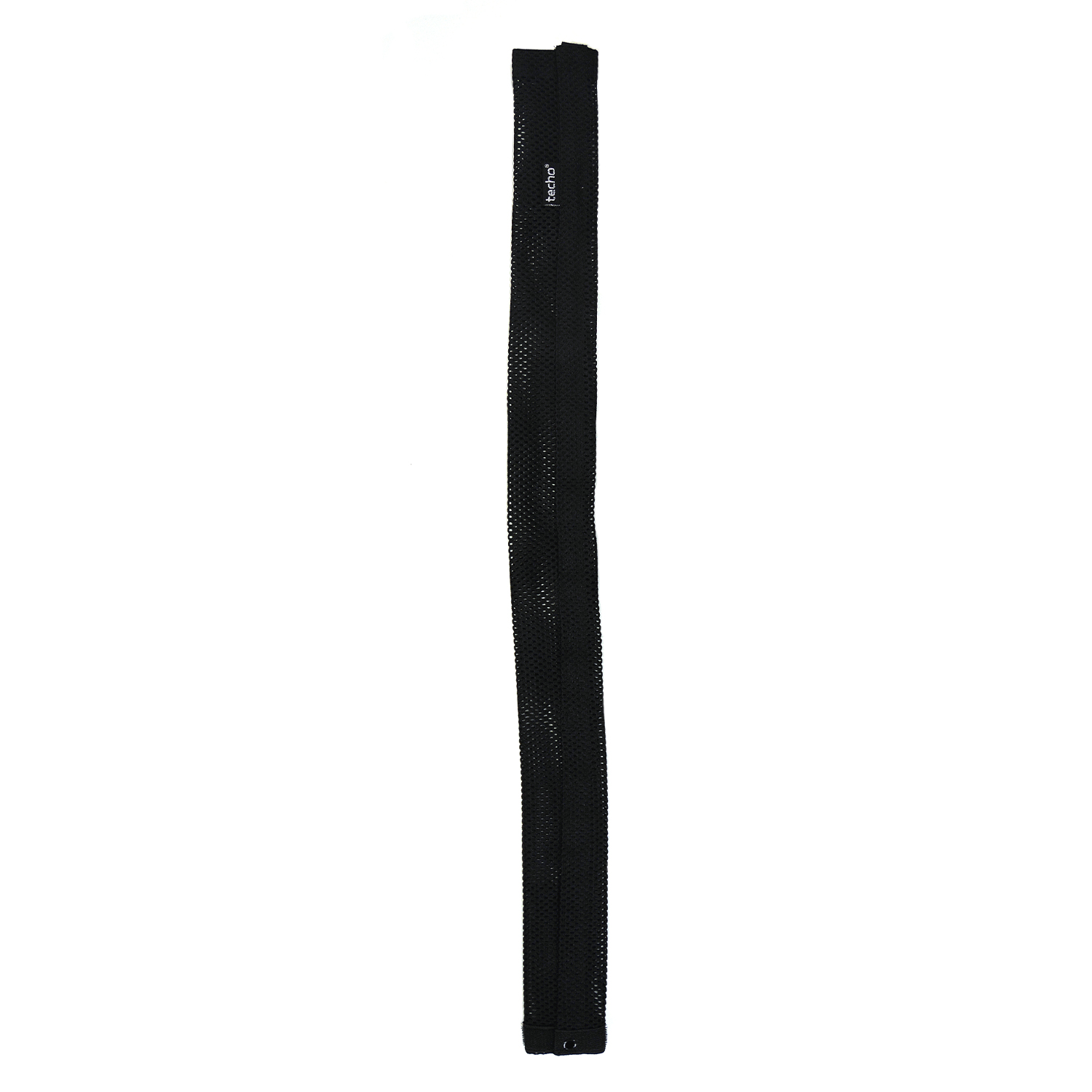
Protective braid made of polyester mesh, closed with Velcro. Wiring harnesses and wiring are easily accessible for maintenance, repair and inspection at any time. Easy to install.
LED table light Alfa 1100
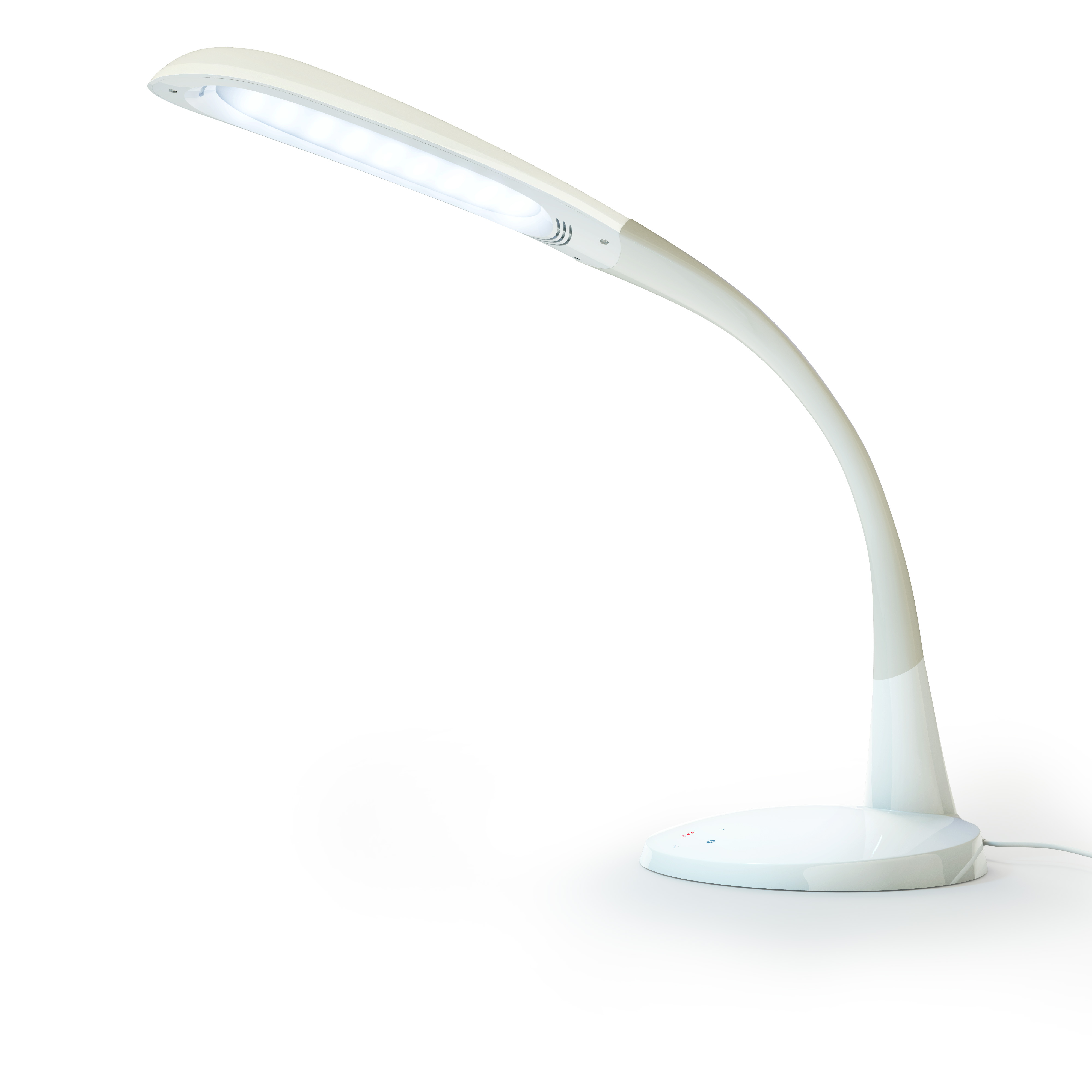
Max. luminosity: 2000 lux
Luminous flux: 700 LM
Light colour temperature:
- 5500 K cool light
- 3300 K warm light
- 4000 K combined light
Operating temperature: <50°C
Using the touch control panel, you can adjust the light intensity in a five-step range, and choose between cold, warm and daylight.
Integrated wireless mobile phone charger
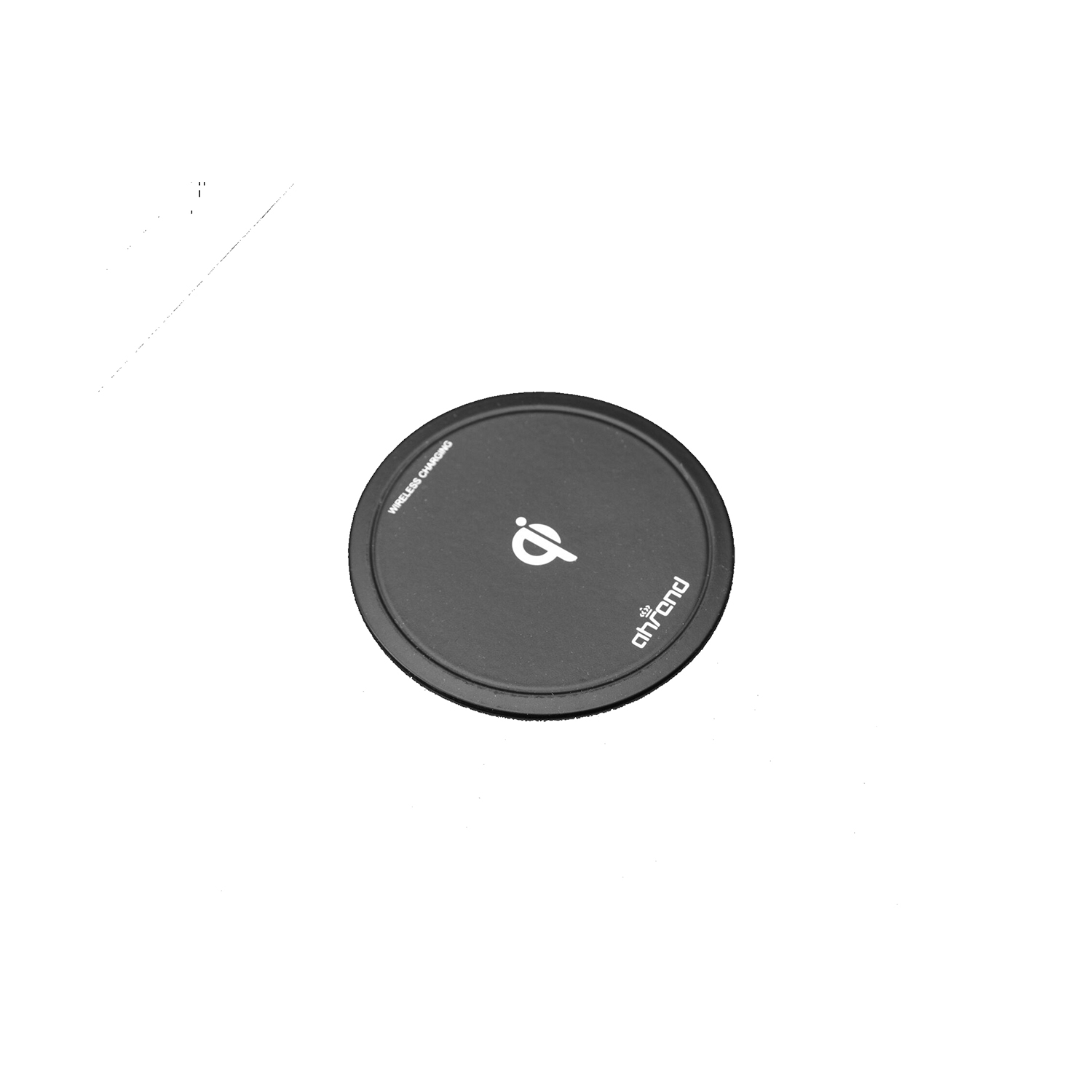
Integrated wireless charger for mobile phones
- Certified according to the international wireless charging Qi standard.
- Intelligent charging ID is able to automatically identify various types of phone and adjust output accordingly.
- Low standby energy consumption with a high conversion rate.
- Installation must be performed by the user with the supplied installation manual.
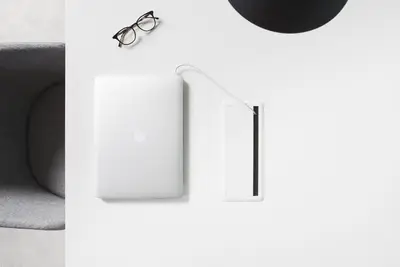
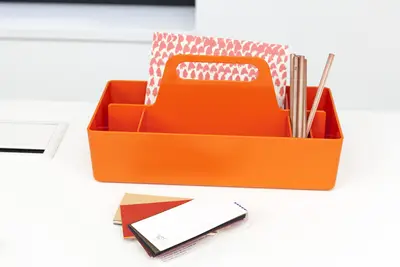
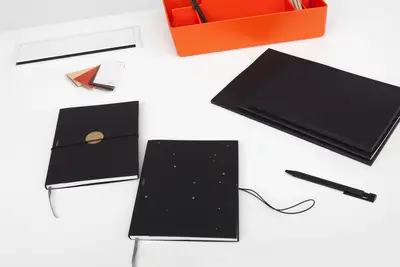
Get inspired by us
We will help you with the equipment of a comfy, functional office in your home. You choose the decor and size and leave the rest to us. You can be working comfortably at home within 5 working days.
Stretching exercises at the end
Chest Stretch
There are two goals for the Chest Stretch. One is to stretch the chest muscles (pectoralis or pecs) which frequently tighten and constrict when you hunch over a desk or keyboard for long periods of time. Another is to strengthen some of the muscles in your upper back and neck which help your body retain its neutral position (i.e., a position in which your weight is evenly distributed and supported by the appropriate muscle groups).
Performing the Chest Stretch
- Bend your arms at the elbows.
- Raise your arms so that your elbows are even with your shoulders, point your fingers towards the ceiling, and point your thumbs towards your neck.
- Look forward and tuck in your chin.
- Slowly squeeze your shoulder blades together.
- Hold the stretch for 5-10 seconds; then slowly relax.
- Repeat 3 times.
Alternate Ways to Perform the Chest Stretch
If you cannot easily raise your arms to the point where they are even with your shoulders
- Raise them halfway, or as high as you can.
- Slowly pull your shoulder blades together from that position.
- Hold the stretch for 5-10 seconds.
- Repeat 3 times.
Or, stretch one arm at a time
- Hold your arm straight out at shoulder level, or as high as you can raise it.
- While facing forward and without bending your elbow, reach backward as far as you can without turning your body.
- Hold the stretch for 5-10 seconds.
- Slowly return your arm to your side.
- Rest.
- Repeat 3 times.
If you feel any discomfort or pain while performing the chest stretch, STOP immediately and consult your physician.
Eye Relaxer
The eye relaxer gives your eyes a chance to rest by changing the objects on which they are focusing. By switching your focus from a nearby object (i.e., your computer monitor) to a distant object (i.e., a tree outside your window or the water fountain down the hall), you stretch the muscles in your eyes by making them refocus. When you sit for long periods of time focusing on one object that is a fixed distance from your eyes, you force your eye muscles to work hard to retain that one position. If your eye muscles are not given an opportunity to stretch by focusing on an object at a different distance, they can become strained, which can ultimately hurt your vision.
Performing the Eye Relaxer
- Look away from your monitor at an object that is across the room, or at least 15 feet away.
- Focus on the object for 15 seconds.
- Close your eyes for 5-10 seconds and gently rub them before returning to work.
Alternate Way to Perform the Eye Relaxer
If there is nothing to focus on that is 15 or more feet away
- Close your eyes for 15 seconds.
- Gently rub them.
If your eyes tire easily or if you have constant pain, consult your eye doctor.
Finger Stretch
The purpose of the finger stretch is to stretch the long finger tendons that are necessary for flexing and extending your fingers and for performing tasks like typing on a keyboard. When you slowly open and close your hands, you prevent the tendons from getting stiff, which can result from retaining one position for too long. Gripping a computer mouse and typing are positions that can lead to stiffening of the tendons.
Performing the Finger Stretch
- Slowly move your fingertips downward into the top of your palm.
- Make a tight fist.
- Squeeze your fist tightly.
- Slowly open the fist, extending all of your fingers as far as possible.
- Hold your hand open for 5-10 seconds.
- Relax.
- Repeat 3 times for each hand.
Alternate Way to Perform the Finger Stretch
If your fingers or hand joints feel too stiff to do the finger stretch as described, use your nonstretching hand for assistance.
- With your free hand, gently help your stretching fingers move into the stretch, as far as you can. If you feel any pain or if your fingers do not move easily stop the stretch.
If you feel any discomfort or pain while performing the finger stretch, STOP immediately and consult your physician.
Lower Back Stretch
The purpose of the lower back stretch is to give the muscles in your lower back and trunk a break from supporting your upper body and limbs. Your lower back and trunk muscles are important for maintaining proper posture and if you do not move your body, they remain static. This stretch moves these muscles so they do not become stiff from lack of movement.
Performing the Lower Back Stretch
- Plant your feet firmly on the floor or a footrest.
- Hold the seat of your chair with your left hand to stabilize yourself.
- Turn your body to look backward over your left shoulder, using your right arm to guide your body through the stretch.
- Hold the stretch for 5-10 seconds.
- Slowly face forward.
- Repeat 3 times for each side.
Alternate Way to Perform the Lower Back Stretch
If you cannot easily perform this stretch in your chair, try to do it standing up
- Stand in front of your desk with your hands on your hips.
- Without moving your feet, twist at the hips toward the right as far as you can.
- Hold the stretch for 5-10 seconds. Then face forward.
- Turn to your left and hold that stretch for 5-10 seconds. Then face forward.
- Repeat 3 times for each side.
If you feel any discomfort or pain while performing the lower back stretch, stop immediately and consult your health care provider.
Neck Stretch I
The neck stretch loosens the muscles in your neck that work together to support your head and keep it centered over your shoulders. Work that does not require you to look around, such as computer work, requires your neck muscles to remain in a fixed position for extended periods of time. This exercise stretches your neck muscles so they do not stiffen.
Performing the Neck Stretch
- Slowly turn your head as far as you can to the left.
- Hold the stretch for 5-10 seconds.
- Repeat toward the right.
- Without lifting your shoulder, tilt your head so that your left ear moves toward your left shoulder.
- Hold the stretch for 5-10 seconds.
- Repeat this stretch on the right side.
- Slowly touch your chin to your chest.
- Hold the stretch for 5-10 seconds.
- Without arching your back, slowly tilt your head back as far as you can to look at the ceiling. Hold this stretch for 5-10 seconds.
- Repeat 3 times.
Alternative ways to perform the Neck Stretch I
- Gently and slowly roll your head clockwise 3 times.
- Gently and slowly roll your head counter-clockwise 3 times.
If you feel any discomfort or pain while performing the neck stretch, stop immediately and consult your health care provider.
Neck Stretch II
This exercise loosens the muscles in the front of your neck (the scalene muscles). When you look down for long periods of time, these muscles can tighten.
Performing the Neck Stretch II (Scalene Stretch)
- Place your hands on your collarbone.
- Look at the ceiling above your left shoulder.
- Hold the stretch for 5-10 seconds.
- Slowly return to looking forward.
- Look at the ceiling above your right shoulder.
- Hold this stretch for 5-10 seconds.
- Slowly return to looking forward.
- Repeat 3 times.
Alternative ways to perform the Neck Stretch II
- Gently and slowly roll your head clockwise 3 times.
- Gently and slowly roll your head counter-clockwise 3 times.
If you feel any discomfort or pain while performing this neck stretch, stop immediately and consult your health care provider.
Shoulder Roll
Many of the muscles in your neck and head start or end near your shoulders. When you sit at a computer with your eyes fixed on the monitor, your shoulder muscles work hard to keep your head centered over your shoulders. These muscles get tired and stiff if they have to stay in one position too long. To prevent this stiffness, the shoulder roll stretches and loosens these support muscles.
Performing the Shoulder Roll
- Relax your shoulders and let your arms dangle at your sides.
- Slowly shrug your shoulders toward your ears.
- Roll shoulders backward in a circle to their original position.
- Repeat 3 times.
Alternative way to perform the Shoulder Roll
- Slowly raise your arms over your head with your palms facing forward.
- Reach as high as you can and then slowly lower your arms.
- Rest.
- Repeat 3 times.
If you feel any discomfort or pain while performing the shoulder roll, stop immediately and consult your health care provider.
Upper Back Stretch
The upper back stretch stretches and strengthens the muscles in your upper back that help maintain your posture. The muscles in your upper back help keep your shoulder blades in position, which helps support your head over your shoulders. When you strengthen these muscles, they provide better support for your posture and are less likely to become overloaded or strained.
Performing the Upper Back Stretch
- Without locking your fingers, place your hands behind your head so that your thumbs face down and rest against the back of your neck.
- Without looking down or bending your neck, squeeze your shoulder blades together.
- Hold the squeeze for 5-10 seconds.
- Slowly release and rest.
- Repeat 3 times.
Alternative ways to perform the Upper Back Stretch
- With your arms at your sides, squeeze your shoulder blades together as if you were placing your elbows in your back pockets.
- Hold the squeeze for 5-10 seconds.
- Relax.
- Repeat 3 times.
If you feel any discomfort or pain while performing the upper back stretch, stop immediately and consult your health care provider.
Wrist Stretch
The wrist stretch stretches the muscles that move your wrists and fingers. The muscles of your forearms move your fingers so that you can type and use a mouse. Because typing is a repetitive task, these muscles work repetitively as you type, and the more they work, the tighter they get, increasing the risk of repetitive strain injury. To prevent these muscles from tightening and overloading, you should stretch them periodically.
Performing the Wrist Stretch
- With your elbow at your side and your arm bent at 90 degrees, hold your hands in front of you with your palms down.
- Keep your fingers together and try not to cup your hand while you slowly bend your wrists as far as you can so that your fingers point upward.
- Hold this stretch for 5-10 seconds.
- Keep your fingers together as you slowly lower your hand so that your fingers are pointing down.
- Hold this stretch for 5-10 seconds
- Repeat 3 times.
Alternative ways to perform the Wrist Stretch
- Hold your arms in front of you with your hands faced down.
- Shake your hands at the wrist for 5-10 seconds.
- Rest.
- Repeat 3 times.
If you feel any discomfort or pain while performing the wrist stretch, stop immediately and consult your health care provider.